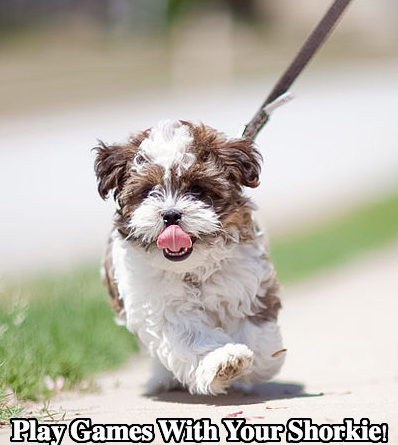Shorkie Dog Temperament Diet and Training
Table Of Contents
- 1 What is A Shorkie?
- 2 History Of The Shorkie
- 3 How to Choose A Shorkie Puppy
- 4 Shorkie Appearance
- 5 Shorkie Temperament
- 6 Annoying Shorkie Habits
- 7 House training a Shorkie
- 8 Grooming A Shorkie
- 9 What to feed your Shorkie
- 10 Tips for breeding a Shorkie
- 11 Shorkie Obedience Training
- 12 Games to play with your Shorkie
If you’re partial to small, cute dogs, welcome the Shorkie into your home. This fellow will bring endless fun to your life.
A dog, especially a rare crossbreed like the Shorkie, is a significant responsibility. This guide tells you what it takes to keep it happy and healthy.
What is A Shorkie?
A Shorkie is a cross between a Shih Tzu and A Yorkshire Terrier. It’s among the designer dog breeds that became popular in the 1990s.

The Shorkie has the attitude of a large dog and has no idea that it’s small-sized. He’s a loyal, loving companion who will bark to tell you that someone’s at the door. He makes an excellent watchdog that will quickly inform you if anything’s afoot.
History Of The Shorkie
The Shorkie is a new hybrid. It will take a few generations of breeding before kennel clubs recognise it. As such, it doesn’t have an extensive history. However, its parents, the Yorkie and the Shih Tzu, do. Thus, we’ll detail a history of its parents before we discuss how it came to be.
1. The Yorkie
Its first parent, the Yorkie, is a terrier breed that hails from Yorkshire, England. A small terrier, it grows to a maximum size of up to 7 pounds.
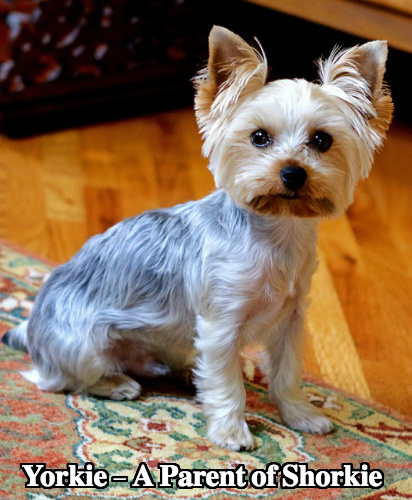
Yorkie breeding started when factory workers from Scotland came to Yorkshire to look for work. They brought various types of small terriers with them. Since most of these men had little education, they left little information behind about its breeding.
The first Yorkie was the offspring of three different dogs. The male was a terrier named Old Crab. History records that a female called Kitty had a part to play in the breeding. Another female Paisley Terrier, which has no name, led to the development of the breed as well.
The first Yorkies didn’t get much recognition at dog shows. Dog show organisers lumped them in the category “Broken-Haired Scotch Terriers.” Their classification at dog shows was absurd.
The most famous Yorkie was a dog named Huddlesfield Ben. He was the best Yorkie stud during its time. He won many dog shows. Breeders regard it as the father of the modern Yorkie.
Yorkies first came to America in 1872. Breeders first registered the Yorkie with the American Kennel Club (AKC) in 1885. It became as popular a pet in America as it did in England. Another war dog named Smoky also helped raise interest in the breed.
2. Shih Tzu
The Shih Tzu, or ‘Chrysanthemum Dog’ is an ancient Chinese breed. ‘Shih Tzu’ is the Chinese word for ‘Lion”. The dog resembles the majestic creature. Breeders indicate, however, that it shares its lineage with wolves. It originated from China around 800 B.C.
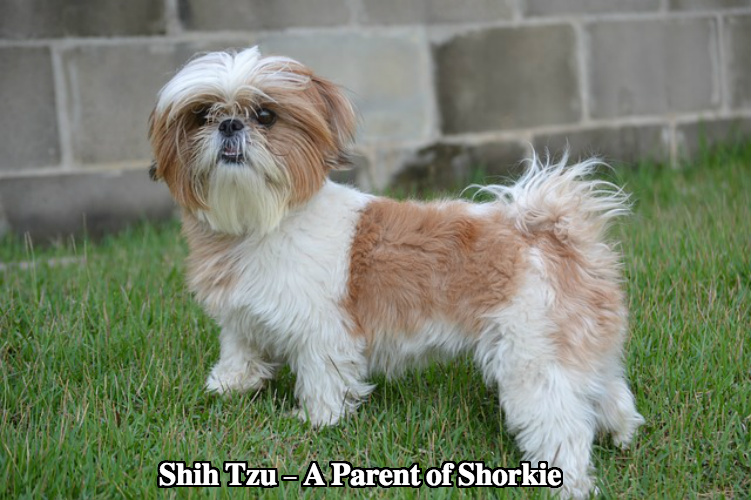
There are many theories about how today’s Shih Tzu came to be. Some breeders say that its a cross between a Pekingese and a Lhasa Apso. They became such prized creatures in China that the Chinese would not share or give any dogs away.
The Shih Tzu first came to Europe in 1930. The Kennel Club classified it as an Apso. The Shih Tzu Club introduced the first standard for the breed in 1935. It arrived in the United States after World War II, when military men brought it back from Europe in the mid 50’s. The American Kennel Club recognised it as a toy dog in 1969. Kennel Clubs the world over now acknowledge it.
How to Choose A Shorkie Puppy
Choosing a crossbreed puppy like the Shorkie is a challenging task. You may get a welcome companion or an unpleasant surprise.
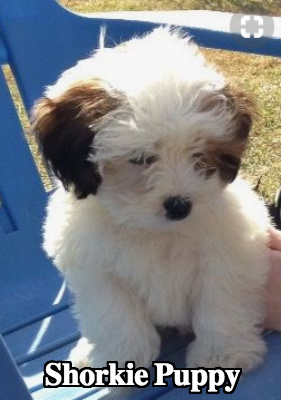
Of course, choosing a puppy requires some knowledge. Here are a few points to consider when picking one out.
1. Pros and things to consider
A. Things to consider
A crossbreed may not cost as much as a purebred dog, but you would need to look after it like you would any other dog. You will need to provide it with a balanced diet, license registration, vaccinations, and parasite control. You will need to groom it as well.
Furthermore, it’s difficult to gauge the size of the Shorkie. You won’t be able to tell which parent it takes after. Thus, it’s hard to predict how big it will grow.
You can’t conclude its personality either. Again, you can’t tell which parent will determine its characteristics and behavioural quirks.
B. The pros of crossbreeds
All said, there is a reason crossbreeds like the Shorkie are popular.
For a start, they will not inherit the health conditions of their parents. Many are hypoallergenic and make excellent pets for those with allergies.
Of course, many take on the desired physical traits of their parents and are unbelievably cute.
2. Choosing a breeder
It’s never wise to purchase a puppy, crossbred or not, from a pet store. Many of them get their puppies from puppy mills, where conditions are dirty and cramped. These puppies are often malnourished and have physical defects.
Buy your puppy from a reputable breeder. This person should be knowledgeable about breeding Shorkies. He should have given all his puppies vaccinations, and allow you to meet its parents. Meeting the puppies’ parents will allow you to predict the physical traits and temperaments they may have. Also, he will breed dogs in spacious conditions. A pregnant dam will have space to whelp.
3. Handling the puppies
When choosing a puppy, you must determine if it’s responsive to handling. Lift or cradle prospective puppies. The less they resist you, the better. Such pups will turn out to become obedient pets.
4. Observe how the puppies behave
Spend time observing the puppies. You’ll be able to identify dominance and submission. Dominant puppies will have more chances to suckle on their mother’s nipples than submissive ones. You’ll be able to pick a puppy that suits your personality.
Shorkie Appearance
Because it is a crossbreed, the Shorkie’s appearance varies from dog to dog. It may take on the physical characteristics of its Shih Tzu parent, which is a bigger and sturdier dog than the Yorkie. It has a perky, proud stance. This dog has straight, V-shaped legs.

Most Shorkies are between 12 to 14 inches in height and weigh between 13 to 18 lbs. They have round, flat heads and large, widely-spaced eyes. These may be blue or brown.
They have short muzzles and a tenacious scissors bite.
Their noses may be either blue, black, or brown.
Their coats lean on the long side. Most are silky, like a Shih Tzu’s. They aren’t very dense, and the hairs are straight. These may be blue, black, red, fawn, or brown.
Shorkie Temperament
So, what type of dog are you likely to welcome into your home?
Like the Yorkie, the Shorkie may be rambunctious. It’s also aggressive and may develop the Small Dog Syndrome if you don’t socialise it well. It can be bossy with other dogs, in particular, large ones.
The good news is that it may turn out more like the Shih Tzu, which is a friendly pet. If this is so, it will love nothing better then a pat and cuddle. It makes a loyal, affectionate companion. In fact, it may be a bit too loving and develop separation anxiety.

Indeed, the Shorkie is excellent with children. It’s patient and doesn’t mind teasing, especially if it takes after the Shih Tzu. Note that you should supervise it during playtime, lest the jokes go too far.
The Shorkie, like its Yorkie parent, is an inquisitive fellow who loves to sniff whatever’s around it. Checking out anything or anyone new to it will be the first item on its daily schedule.
The Yorkie and Shih Tzu love chasing birds, so the Shorkie would too. Make sure that you fence it up well, lest it gets lost hunting prey. Yorkies and Shih Tzus are lively, and the Shorkie would be too.
Like the Yorkie, the Shorkie is a small, delicate lap dog. It loves comfort, so don’t be surprised if it climbs on your sofa to nap on occasion.
The Shorkie loves making announcements, like its gregarious Yorkie parent. It will prompt you whenever anyone’s at your door. Put in measures to control it’s barking. Do remember that alert as they are, Shorkies are a little too small to be guard dogs, but they will let you know if anything strange is afoot.
The Yorkshire Terrier is known for being bold and courageous. Don’t be surprised if your little Shorkie turns out the same. Prevent it from running out and chasing cars on roads.
The Shorkie, like its Yorkie relative, may be willful and opinionated. Put it through obedience classes as soon as possible. Note that it may hate walking on a leash. Let it get used to the process as a puppy.
Like its Shih Tzu parent, the Shorkie will be intelligent. It will be a happy fellow as well. This crossbreed will also be playful, since both its parents are.
Annoying Shorkie Habits
Let’s face it. Owning a dog is a challenge. Like humans, they have behaviours that can be a pain. Here are some of a dog’s most annoying habits and the steps you can take to manage them.

1. Barking
Shorkies make excellent watch dogs, and will let you know if a stranger’s at your door. While you won’t have to install a doorbell, it’s barking may annoy your neighbors.
As you can see, some barking is beneficial. The key is getting your dog to stop when necessary. Close your dog’s muzzle gently when it barks. Accompany this action with the words ‘No speak’. Do this a few times. Your pet will eventually get the message that it’s supposed to end its speech.
2. Jumping
Shorkies are friendly and approach almost everyone with an enthusiastic greeting. However, they may be a little too sociable for some. Moreover, their nails may be too sharp.
Don’t greet your pet immediately when you enter the home. Doing so will only increase its nervous energy. Remain assertive until your pet calms down. Pay attention to it after it does so.
3. Chasing
This is a behaviour that you’d want to stop because it may lead to an accident. If your dog enjoys chasing other dogs or cars, here’s what to do.
Your dog should understand the ‘sit’, ‘come’ and ‘stay’ commands. It should respond to these immediately.
Give your pet alternative opportunities to play Chase.
Dog parks and beaches are places where you can let it ran after you.
4. Begging
If you have a greedy Shorkie, you’ll want to get it to stop asking for food at the table. Feed it when you have your meal; it’ll be too distracted eating. Never pay attention to begging behavior, even with a negative ‘no’. Your dog will take this response as a license to continue doing it.
5. Digging
It’s frustrating to come home to an uprooted garden.
Fortunately, Shorkies don’t really have a propensity for digging. If yours does, give it a spot in your garden where it can do so.
6. Nipping
This habit may seem cute, but may lead to aggression if not controlled. Let out a yelp when your dog nips you and don’t handle it for a while. Shorkies are emotionally intelligent; they’ll understand that mouthing hurts others. Yours will stop doing so once it gets the message.
7. Aggression
You don’t want your neighbors and their pets running in the opposite direction when they meet your dog. Nip aggressive behaviour in the bud.
Socialize your Shorkie as often as possible. Let it meet people and their pets on daily walks. Also, consciously avoid situations where conflicts may arise.
8. Separation anxiety
This behaviour is one to look out for if you own a Shorkie. It’s a sociable. loyal dog which can’t be left alone for too long.
Train it to be used to your absence. When leaving the home, say goodbye to your pet, but don’t make a fuss. That assures the dog that you won’t be away for too long. Soft music will calm it down as well.
House training a Shorkie
House training a Shorkie can be a challenge because it’s somewhat stubborn. However, you can manage it if you put sensible practices in place.
Remember not to hit your dog when it gets into an accident. Doing so will only make your pet frightened and serve no other purpose.
1. Routinising
First of all, it’s essential that you establish routines for your willful Shorkie puppy. Puppies typically ease themselves after they get up, eat, or before they go to bed. Take it outside during these times. It is also vital that you take it to the same spot to relieve itself when you do. Do keep it on a leash.
2. Crate training
Not every pet lover is an advocate of crate training because keeping a dog confined seems inhumane. However, a crate has its uses. You’ll need it if you take your pet on road trips or to the vet. It’s also your pet’s space. Most importantly, a crate reminds a dog that it can’t relieve itself just anywhere.
When choosing a crate, make sure that your Shorkie hand stand up, sit down, turn around, and lie down in it. If it’s too big, your dog’s likely to choose a spot where it can ease itself.
To get your pet to use it, put a treat in it. Leave the door open. Your pet will find the crate inviting and go in on its own.
3. Paper Training
You’ll have to get your pet to use newspapers if you live in an apartment. Your dog will have no yard where it can relieve itself.
Lay the area that you want your dog to use as its potty with newspaper. Enclose it with cardboard boxes, and leave the dog in it. Your dog will gradually become used to easing itself there. Once it is, take some of the paper away. Your dog will become accustomed to using a smaller area.
A pan is a useful alternative if you don’t wish to use newspapers. The only difference you’ll notice when training your Shorkie to use it is that there’s no space to shrink.
4. Using Bells
A bell so useful training tool. It reminds your puppy that it needs to go. Use it if you have a doggy door.
Get your puppy to hit it when it’s potty time. The sound will tell it that it’s time to ease itself.
Grooming A Shorkie
Dogs like the Shorkie are eye-catching, but you must groom them well. You don’t have to spend a bomb on your dog’s hairdo if you follow a few tips.
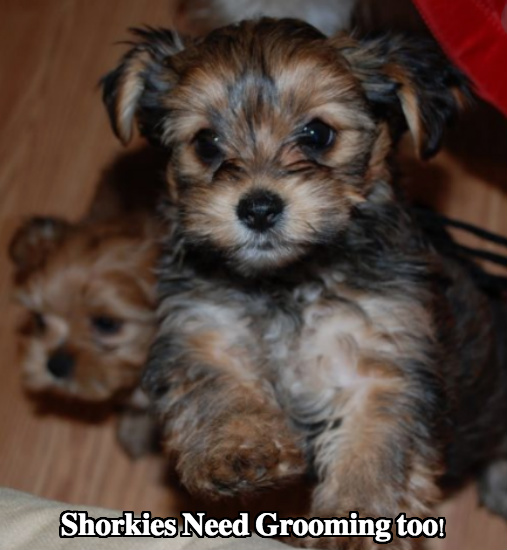
1. Bathing
First of all, bathing dogs with long hair is a skill. You’ll have to prevent its lovely locks from becoming tangled.
A good idea when bathing the Shorkie is to work from top to bottom. Massage dog shampoo into its fur and work from its head to its tail. Working in the direction of hair growth helps to prevent matting.
Place cotton balls in the dog’s ears to prevent liquid from collecting in them. Remember to remove them after the bath.
2. Drying
You can let your dog’s hair dry by itself, or use a hot air blower. Be mindful that long haired dogs will take about two to three hours to dry.
3. Brushing
You need to brush long-haired dogs regularly to prevent tangles. It also helps to invigorate the dog’s skin. You’ll need a Slicker brush or a rotating comb.
The Shorkie is a small fellow; you can put him on your lap. Brush in the directions the hair is growing. Don’t forget to comb the hair on your dog’s belly. To do this, turn it upside down. Brush its ears with a pin brush.
Brush the dog’s hair in sections. Separate a part of the dog’s fur. Brush away all mats and tangles. Repeat this process for the other sections.
4. Cleaning the ears
The best time to clean your dog’s ears is when it’s fur is dry. You can also apply tick prevention medication in the ear. A dog’s ear canal is much longer than ours. Debris frequently collects in the inner ear, so regular cleaning is necessary.
Fold the ear back and administer the anti-tick medicine. Clean the outer ear. Don’t probe too deeply into the ear as you may damage the eardrum.
5. Nail trimming
Dogs don’t usually enjoy having their nails trimmed. It’s difficult to blame them because it’s a painful process if done incorrectly.
You can use Scissor Clippers, Guillotine Clippers, or Grinder Tools for this task. Guillotine Clippers, which have blades, are best for small dogs like the Shorkie.
Get your dog used to having its nails cut. Massage its paws gently. Cut carefully, avoiding the quick. Penetrating this pinkish area will cause profuse bleeding and pain. Trim off one nail at a time so that your dog doesn’t feel overwhelmed.
What to feed your Shorkie
Proper feeding and nutrition are essential for keeping your Shorkie in top form. What you feed your dog determines its health. You should know how often and the type of food to feed your pet as well.

1. How often should I feed my Shorkie?
Shorkies will breastfeed every 2 hours during the first four weeks of their lives. Feed yours milk if its mother isn’t present. Reduce the feeding gradually after eight weeks. Don’t feed it with too many treats because it won’t want to eat its meals.
2. How much should I feed my Shorkie?
A puppy usually gets the necessary nutrients from its mother. If she’s not around, however, you need to replace her milk.
A safe amount to feed your pet is about a quarter of its weight. Adjust the amount as the puppy grows. Feed your puppy about half a cup of solid food at first. A quarter cup is enough for an adult dog.
3. What type of food should I give my Shorkie?
Puppies don’t need anything but their mother’s milk during the first month of their lives. Use a dog milk replacer if your puppy’s mother isn’t around.
It can start eating a tiny amount of dry food, mixed with water, from week 5. Choose food formulated for small dogs. Make sure that it enhances the dog’s muscle and skeletal development.
You can feed your adult Shorkie food for humans. Here are a few that you can add to its diet.
You can give your pet unsalted peanut butter, which is a source of protein and fibre. Make sure that you choose the all-natural version because the manufactured one has the ingredient Xylitol, which is harmful to pets.
Greek yoghurt, without sugar, offers protein. Lean meat has healthy fat and helps a dog to maintain its weight.
Salmon is another healthy food that you can consider giving your Shorkie. The Omega 3 fatty acids in it are beneficial for your dog’s skin and coat. It’s also a healthy protein source.
Rice and pasta provide your dog energy. They are healthy sources of carbohydrates. Just remember not to add sauces.
Apples are potent sources of vitamins A, and C. Remember not to give your pet the seeds.
Green beans are a low-calorie food that provide potassium. They are also a source of vitamins C and K.
Avoid feeding your dog chocolate, which has the toxic agent, theobromine. Grapes aren’t safe either because they may cause kidney disease. Large amounts of onion and garlic may irritate the gut. Milk and dairy products have the same effect.
Tips for breeding a Shorkie
Breeding dogs, especially crossbreeds like the Shorkie, is challenging and rewarding. It also takes months (even yeurs) of planning to get a dam to produce a healthy litter of pups. Hence, is your first- time breeder, you’ll appreciate a few tips.
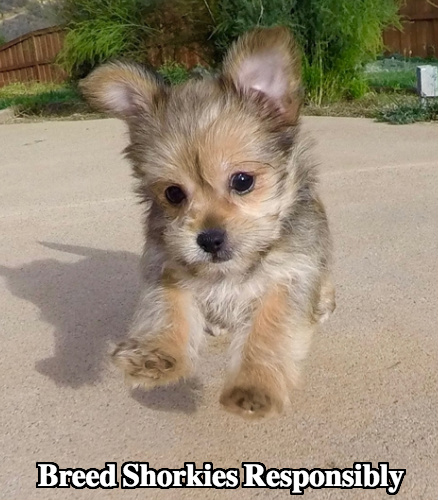
1. Educate yourself
First of all, educate yourself about Shorkies. Find out about the temperaments and physical characteristics of Yorkies and Shih Tzus. The knowledge gives you an idea of the litter of pups you’re likely to get.
2. Avoid breeding your dog too early
Don’t read your female too early. Make sure that your vet has vaccinated her. She’s ready to breed after about 24 months.
3. Look into your dog’s health
Get your vet to give your Shorkie a complete physical check. Ensure that all vaccinations are current.
4. Seek your breeder’s help
Ask your breeder’s opinion about finding a perfect mate for your pet. Look out for temperament and physical problems of potential partners. Have a ‘backup’ mate lest there are issues.
5. Craft a contract
Discuss with the mate’s owner about the future ownership of the puppies and how many of them you wish to put up for sale.
6. Advertise
Start advertising the availability of the puppies. You may want to set up a website that gives people information about the puppies’ parents. You should also put up photographs of the pups.
7. Find out if your dog is ready to breed
Get your vet to do a test to determine if your dog is ready to breed. You have the option of having an ultrasound conducted to confirm the pregnancy.
8. Take care of your dog’s well-being
Make sure that your pet gets plenty of nutrition before breeding.
9. Prepare whelping supplies
Have a whelping box on hand. There should be enough space for the dam and its pups. Your whelping supplies should include a thermometer, syringe, thermostat and gloves. Of course, you mustn’t forget coffee and snacks for yourself.
10. Get Assistance
Get a person who’s an experienced dog handler to help you with the puppies. He should be a person who can come at a moment’s notice.
11. Have cash on hand
You should have cash on hand should there be emergencies during the whelping process. You will need money for vaccinations and trips to the vet.
12. Keep important contact numbers
You’ll need to keep essential contact numbers on hand. Make sure that you know the contacts of your breeder and veterinarian.
Shorkie Obedience Training
Obedience training is necessary for keeping the feisty Shorkie in line. Hence, there are a few basic commands you should introduce to your pet.
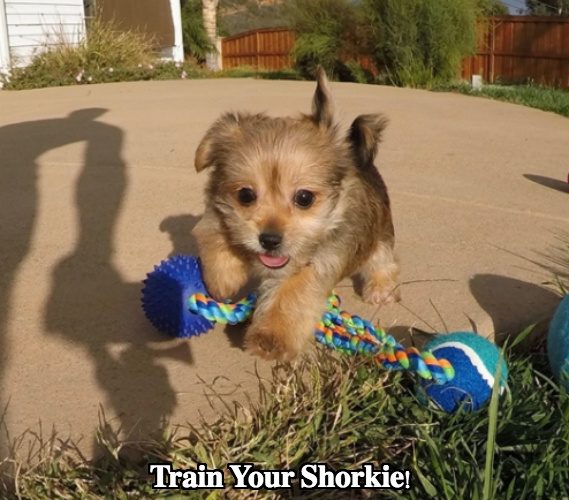
Remember that you should never use harsh punishment, as this will only frighten the dog. All dogs love rewards, so reinforce desired behaviours with treats.
1. The ‘Sit’ Command
Every dog should know how to sit. You will need to use it when you want to stop your pet from wandering around and jumping on your guests.
To teach it, get down in front of the dog. Hold the treat in front of your dog’s nose. Give the command ‘Sit” and lift it over the dog’s head. Your dog will naturally get into a sitting position as it tries to get the food. When it’s in this position, reward it with the treat.
2. The ‘Stay’ Command
Once your dog has mastered the ‘Sit” command, teach it to stay. Have it on a leash.
Stand to face your pet and slacken the leash. Say ‘Stay’ and take a few steps back. Wait for a few seconds, then go back to your original position.
Put your foot gently on the leash. Your foot restricts the dog’s movements and gets it to associate the word ‘stay’ with remaining still. You’ll gradually be able to
take a few more steps back, and your pet will be able to stay for longer durations.
3. The “Come” Command
Teach your dog how to ‘come’ in a quiet, indoor area. Squat in front of the dog and stretch your arms wide open. Say “Come” in a happy voice.
Reward your pet with verbal praise or a yummy treat if it comes to you. Make sure that you don’t grab it, as it will be confused.
If your puppy doesn’t come on command, go to it and leash it. Bring it to the spot from where you first called it. Keep praising it. The praise shows the dog that it has to do as you say, but that you’re not be angry with it.
4. The ‘Heel” command
You’ll find this instruction useful for keeping your pet close to you as you walk on a busy road.
To teach it, get the dog to stand next to you. Have a squeaky toy in one hand and the leash in the other
Put your right arm across your body, so that is on top and a little in front of your dog’s head. Say ‘heel’ and step forward confidently. Your dog should follow suit.
Squeak the toy if the puppy gets distracted. After it follows you successfully for a time, give it the toy and praise it.
5. The Down’ Command
This command is challenging to teach because it involves some submission. However, it’s necessary to use it when you want your dog to stop jumping on your guests.
To teach it, kneel down and get your Shorkie to sit on your left. Put your left hand on its shoulder and the right one behind its front paws.
Say “down’ and press on its shoulders. Push its legs out at the same time. Stroke it and get it to relax. Then, reward it with a treat.
Games to play with your Shorkie
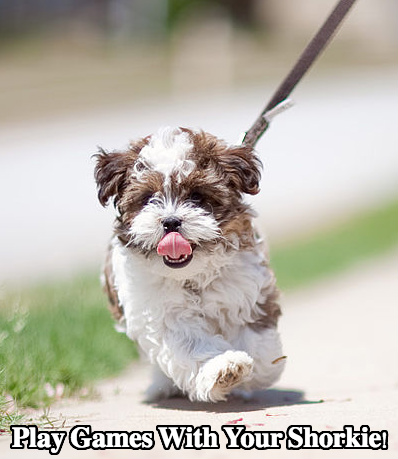
It’s raining, and you can’t take your frustrated Shorkie out for a walk. What should you do? Play games, of course.
These games are suitable for your Shorkie, particularly if it likes staying indoors. They are simple and will keep your dog engaged for hours.
1. Hide and seek
Hide and seek is a simple game that you can play in your living room. Get someone to hold your pet in another place. Meanwhile hide treats everywhere,
Once you are ready, call your dog out and challenge it to find all the goodies. They are the reward for its success.
2. Which box
Have five cardboard boxes, with a treat underneath one of them. Note that they should open from the top.
Get your dog to enter the room and encourage it to find the treat. It should be able to use its scent. As your dog gets used to the game, add more boxes.
3. Treasure box
Assemble a box filled with miscellaneous items such as clothes, bottles, and newspaper. The idea is to place a treat inside one of these items. Get your dog to look for the goodie. You can vary the things in the box as your Shorkie gets used to the game.
In all, the Shorkie is an intelligent crossbreed that doesn’t need extensive care. However, you should choose your puppy wisely. Proper nutrition will keep it healthy and alert. Training and a few games will keep it alert and engaged.
